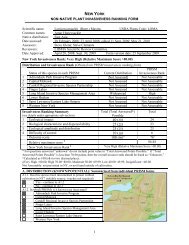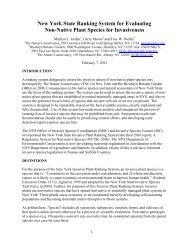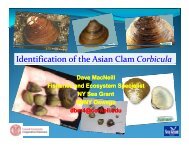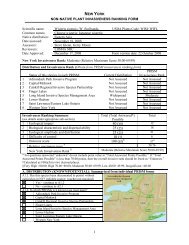Spotted Wing Drosophila (Drosophila suzukii)
Spotted Wing Drosophila (Drosophila suzukii)
Spotted Wing Drosophila (Drosophila suzukii)
Create successful ePaper yourself
Turn your PDF publications into a flip-book with our unique Google optimized e-Paper software.
<strong>Spotted</strong> <strong>Wing</strong> <strong>Drosophila</strong> (<strong>Drosophila</strong> <strong>suzukii</strong>)Published on Fruit Advisor (http://extension.umass.edu/fruitadvisor)Home > <strong>Spotted</strong> <strong>Wing</strong> <strong>Drosophila</strong> (<strong>Drosophila</strong> <strong>suzukii</strong>)<strong>Spotted</strong> <strong>Wing</strong> <strong>Drosophila</strong> (<strong>Drosophila</strong> <strong>suzukii</strong>)Background[1]<strong>Spotted</strong> <strong>Wing</strong> <strong>Drosophila</strong> (<strong>Drosophila</strong> <strong>suzukii</strong>), SWD, is a recently introduced new species of fruit fly in theUnited States. It was first found on the west coast in 2008, but has rapidly colonized many fruit producingregions of the country. It was found in New England in late summer 2011 shortly after Hurricane Irene andcaused significant crop damage in fall raspberries among other crops. While fruit flies (or vinegar flies) arenothing new in the US, this species is different in it's ability to infest healthy fruit. Other species typicallyinfest over-ripe or damaged fruit. Females of this species have serrated ovipositors that can cut intohealthy fruit to insert eggs. This can lead to problems with deteriorating fruit in the field or with customerswho find multitudes of larvae in fruit after harvest.Crops at RiskThis insect has a wide host range but is primarily a pest of berry crops and some stone fruits (cherry,nectarine, peaches), but may also be found in high tunnel tomatoes.Crop Host Crop Host Wild HostApple Grapes American PokeweedAsian Pear Italian Plums Autumn OliveAsian Plum Mulberries Beach PlumBlackberries Nectarines Climbing NightshadeBlueberries Peaches CrabappleBoysenberries Persimmons Fox GrapeCherries Plumcots Japanese YewCold Hardy Kiwis RaspberriesKousa Dogwood
<strong>Spotted</strong> <strong>Wing</strong> <strong>Drosophila</strong> (<strong>Drosophila</strong> <strong>suzukii</strong>)Elderberries Strawberries PorcilainberryTomatoesWild RoseIdentification/LifecycleThe first step in dealing with this new pest is identification. <strong>Spotted</strong> <strong>Wing</strong> <strong>Drosophila</strong> is a small vinegar fly.Both males and females have red eyes. Males have two spots on their wings, which is a key identifyingfeature. Females lack the wing spots but have a robust and serrated ovipositor that distinguishes themfrom other species of fruit fly. Seeing the ovipositor requires some magnification; a hand lense will do.Overwinter as adults and maybe pupae in leaf litter, duff, and rotting fruitAdult flies live for up to 2 weeksFemales can lay 300 eggsCan develop from egg to adult in as little as 8 daysLikely to have over 10 generations per growing seasonDamage:Females lay eggs in fruitLarvae eat flesh, which renders it unmarketable or causes customer discontent (infested fruit ‘meltsdown’ in 2 days)Egg laying introduces fungal pathogens, which rot fruitSignificance:Unlike other fruit flies, SWD attacks sound ripening fruitOnce eggs laid in fruit, no longer able to control with pesticidesShort lifecycle and overlapping generations make spray timing difficultRequires sprays near harvest timeRequires multiple sprays which can lead to pesticide resistanceManagement:MonitoringUse traps to establish presence and abundance of SWDSet traps out prior to fruit ripening to establish onset of infestationCheck traps frequently (at least once per week)Replaice bait weekly to maintain effectiveness (don't dump old bait on ground; remove from field)IdentificationControlUse sticky cards inside traps or sieve contents to and check to confirm presence of SWD (males areeasiest to see)Use hand lense and ID key to help with IDRecord date and number of SWD caught to determine trend
<strong>Spotted</strong> <strong>Wing</strong> <strong>Drosophila</strong> (<strong>Drosophila</strong> <strong>suzukii</strong>)Sanitation - keep area free of overripe fruit to reduce habitat for build up; eliminate wild hosts as muchas possibleExclusion - small areas can be covered with fine netting or row covers prior to fruit ripening to keepSWD outBiological Control - researchers are looking for suitable predators, parasitoids, pathogens and otherbeneficial organisms that might help suppress SWD populations.Chemical Control - use of short residual pesticides (organic and conventional) are likely the mosteffective short term solution for this pest.Table 1. Insecticides for Blueberries, Strawberries, Caneberries, Grapes and Stone Fruit for <strong>Spotted</strong><strong>Wing</strong> <strong>Drosophila</strong>ActiveIngredientTradename1IRACcodeBlueberryPHI (days)REICaneberryPHI (days)REIStrawberryPHI (days)REIGrapes PHI(days) REIStone FruitPHI (days)REICarbaryl Sevin 1A 7 12 hrs 7 12 hrs 7 12 hrs 7 12 hrs 3 12 hrs GoodProbableEfficacyDiazinon Diazinon 1B 7 5 days 7 5 days 5 3 daysNotlabeledNotlabeled21 4 days ExcellentMalathion Malathion 1B 1 12 hrs 1 12 hrs 3 12 hrs 324-72hrs1 or 3 12 hrs ExcellentMethomyl Lannate 1A 3 48 hrsNotlabeledNotlabeledNotlabeledNotlabeledNotlabeledNotlabeledNotlabeledNotlabeledExcellentPhosmet Imidan 1B 3 24 hrsNotlabeledNotlabeledNotlabeledNotlabeledNotlabeledNotlabeled7 3 day GoodBifenthrin Brigade 3 1 12 hrs 3 12 hrs 0 12 hrsNotlabeledNotlabeledNotlabeledNotlabeledExcellentEsfenvalerate Asana 3A 14 12 hrs 7 12 hrsNotlabeledNotlabeledNotlabeledNotlabeled14 12 hrs ExcellentFenpropathrin Danitol 3 3 24 hrs 3 24 hrs 2 24 hrs 21 24 hrs 3 24 hrs ExcellentPyrethrin Pyganic* 3A 0 12 hrs 0 12 hrs 0 12 hrs 0 12 hrs 0 12 hrs GoodZetacypermethrinMustangMax3 1 12 hrs 1 12 hrsNotlabeledNotlabeled1 12 hrs 14 12 hrs ExcellentImidacloprid &cyfluthrinLeverage360 & 2.74A, 3NotlabeledNotlabeledNotlabeledNotlabeledNotlabeledNotlabeled3 12 hrs 7 12 hrs ExcellentActamiprid Assail 4A 1 12 hrs 1 12 hrs 1 12 hrs 7 12 hrs 7 12 hrs FairImidacloprid Provado†† 4A 3 12 hrs 3 12 hrs 7 12 hrs 0 12 hrs 0-7 12 hrs FairThiamethoxam Actara 4A 3 12Spinetoram Delegate 5 3 4 hrs 1 4 hrsNotlabeledNotlabeled7 4 hrs 7 4 hrs ExcellentSpinetoram Radiant 5NotlabeledNotlabeledNotlabeledNotlabeled 1 4 hrs NotlabeledNotlabeledNotlabeledNotlabeledExcellentSpinosad Entrust*,†† 5 3 4 hrs 1 4 hrs 1 4 hrs 7 4 hrs 1 - 14 4 hrs Good/ExcPyriproxyfen Esteem 7 7 12 hrsNotNot2 12 hrs 21 12 hrs 14 12 hrs Fair/Good
<strong>Spotted</strong> <strong>Wing</strong> <strong>Drosophila</strong> (<strong>Drosophila</strong> <strong>suzukii</strong>)labeledlabeled*OMRI listed†† Stone Fruit: there are different PHI depending on specific stone fruit crop, check label before usingPHI= pre-harvest interval; time between last application and harvestREI= re-entry interval; time between application and when workers may re-enter the fieldProbable ratings based on lab and field assays in western USA and MichiganChart courtesy of Mary Conklin, UConn ExtensionHowever:Requires a short pre-harvest interval (PHI)Requires > 5 day residual activityRequires rotation among mode of action (MoA) to avoid developing resistanceSource URL: http://extension.umass.edu/fruitadvisor/news/spotted-wing-drosophila-drosophila-<strong>suzukii</strong>Links:[1] http://extension.umass.edu/fruitadvisor/sites/fruitadvisor/files/images/SWD-male-250_0.jpg











